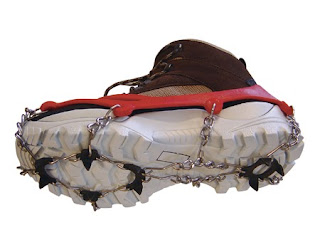Before going onto a frozen lake, pond or river, it's important to take safety precautions to reduce the risk of falling through the ice. Remember you take a risk any time you go onto the ice. Anglers should always decide for themselves if it is safe to go out and walk on or drive a snowmobile on ice.
Knowing how to judge ice conditions will help you make more informed decisions while enjoying your outing. Ice thickness depends on several factors with the first and most obvious factor being location. The type of *water* also affects ice thickness; a shallow lake will freeze faster than a deep lake. Look for clear blue ice. New ice is stronger than old ice. Ice thickness is not consistent. Beware of ice around partially submerged objects such as trees, brush, embankments or structures. Ice will not form as quickly where water is shallow or where objects may absorb sunlight.
When ice fishing, it is always a good idea to drill test holes or use an ice chisel as you venture onto a lake to help judge the thickness and character of the ice. These “Test” holes should be at no more than 30 foot intervals.
You should also have a safety kit specific to ice fishing whenever you go. The items on this list will help prevent someone or something from falling through the ice. If you or someone else should fall through the ice, know how to use these tools to perform a self-rescue or assist in a rescue. The safety kit should include the following:
* Ice chisel or auger to check the ice thickness.
*Always carry ice picks or set of screw‐drivers that will float and are securely connected together with a piece nylon cord 24 to 30 inches in length. These picks should be carried allowing for quick and easy access so you can pull yourself out of the water and back onto the ice. “Pick‐of‐Life” ® is a product which is commercially available.
*50 feet of nylon rope with a large loop tied to each end.
*Wool blanket.
*Thermos of HOT liquids.
*A cell phone or portable CB to call for assistance.
The use of crampons, or cleats, for walking on ice are always a good idea in Northern Michigan. With the state’s powdery snow and wind, there is often no snow cover on ice. Blowing wind and snow actually polish ice to a glassy, slippery surface.
Attaching a long cord to sleds should make them easier to pull, and if someone falls through the ice, anglers can push their sled to them while holding onto the line.
Anglers should carry two picks—or spikes protruding from wooden hand holds—that will float and are securely connected together with a piece nylon cord 24 to 30 inches in length. These picks should be carried allowing for quick and easy access in case anglers need to pull their way out if they fall through the ice.
Ice fishermen should carry a portable flotation cushion. The cushion will add to their seating comfort and give them something to throw should someone fall through ice.
Anglers should keep their augers covered because the blades are sharp, and can easily cut them, their children or their dogs.
Ice fishermen should spray vegetable oil on their auger and snowshoes. That way, snow won't stick and anglers won't cut themselves cleaning off the snow.
Beware of ice covered with snow. Snow acts much like a blanket, insulating thin ice and preventing the formation of clear, blue ice. Snow can also hide cracked, weak and open water. Daily changes in temperature cause ice to expand and contract, creating cracks and possibly pressure ridges which can affect ice strength. Extreme caution should be exercised when approaching a pressure ridge. Ice may be unstable up to 20 feet from the ridge itself.Stay away from cracks, pressure ridges, slushy or darker areas that signify thinner ice.
Traveling on a snowmobile or ATV early or late in the season is an accident waiting to happen. Do not drive across ice at night or when it is snowing. You can easily become disoriented and end up in areas of the lake you never intended to be.
Have fun! But always remember to
*Be Safe Out There!*
For weekly updates on the ice and snow conditions surrounding Drummond Island, be sure to check out the Drummond Island MI Snow Report page on Facebook!
*Be Safe Out There!*
For weekly updates on the ice and snow conditions surrounding Drummond Island, be sure to check out the Drummond Island MI Snow Report page on Facebook!














No comments:
Post a Comment